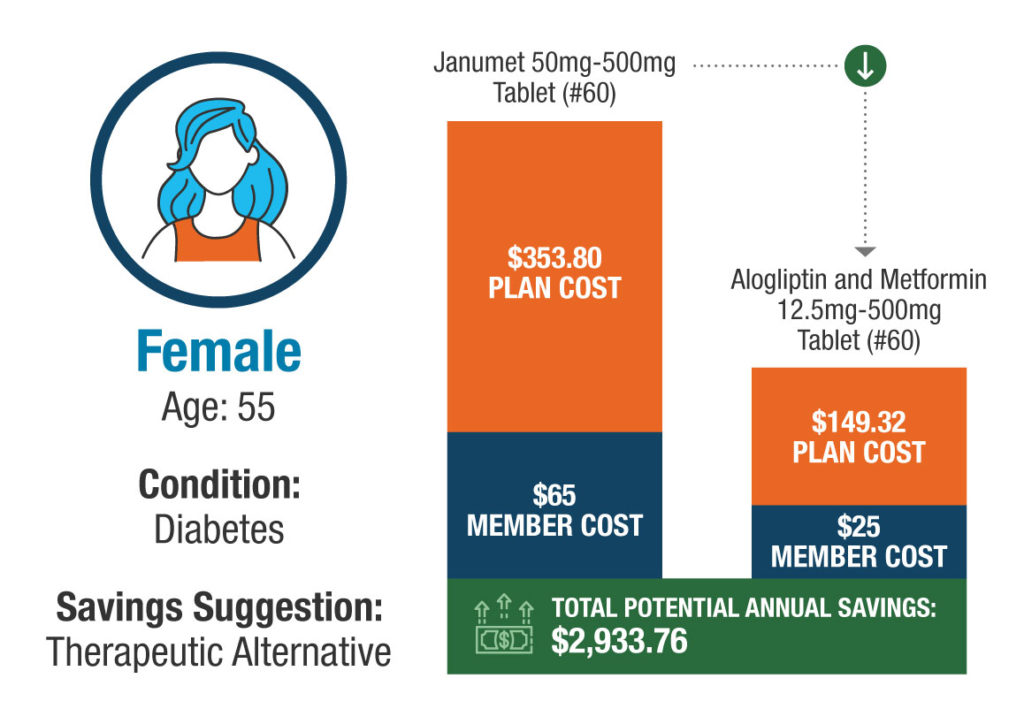A collection of clinical insights from Rx Savings Solutions’ team of in-house pharmacists. These industry veterans curate, update and review our patented technology’s 34,000+ clinical, dose-adjusted savings suggestions—and they’ve got expertise to share.
Check back for more condition-focused content, featuring key trends we’re seeing in utilization, medical management, pricing, therapeutic alternatives and more.
———————————————–
We’ve been recognizing American Diabetes Month the same way we treat every other month: By helping members find the lowest-cost options to treat this chronic condition. Let’s take a closer look at this ever-evolving category of medication and see how we’re uncovering savings opportunities for clients and their members.
Condition Summary
Diabetes is a chronic (long lasting) health condition that affects how the body turns food into energy. Sugar gets into the body’s cells with the help of a hormone called insulin. If there’s not enough insulin, or if the body stops responding to insulin, sugar builds up in the blood. There are two main forms of diabetes:
- Type 1 – The body doesn’t produce its own insulin
- Type 2 – The body doesn’t use insulin properly
Treatment
There’s no cure for diabetes, but there are multitudes of medications on the market used to help decrease symptoms and overall effects on the body. Treatments are available in various forms: tablets, capsules, combination products, injections, pumps, or even inhalation products.
Treatment will depend on the type of diabetes an individual is diagnosed with:
- Type 1- Typically involves insulin injections or possibly an insulin pump, along with frequent blood sugar checks and special diets.
- Type 2 – Also includes dietary considerations and blood sugar monitoring, but can also be treated with medication, insulin—or both.
Utilization Snapshot
Here’s a look at diabetes treatment we’ve seen based on 2021 claims data:
- 238 prescribed products for diabetes
- 2021 member costs = $231M
- 2021 plan costs = $1.5B
- 2021 average total cost per claim = $903
- Lowest = $6.76
- Highest = $31,894.90
Key Trends
1 – There is a lot to keep track of within the diabetes medication market. Whether for Type 1 or Type 2 diabetes, it’s important for plans to have a strong understanding of what’s offered within their formulary design to ensure they’re maximizing savings for everyone.
2 – Metformin is first-line treatment for Type 2 diabetes and a great example of where we often find cost savings for members and plans. Metformin comes in multiple forms—both immediate release and extended release. The extended-release category includes three different forms due to the differences in which they are released in the body. Clinically speaking, these extended-release products create the same overall effect. However, their price points are drastically different and could persuade a member to choose one over the other.
- Metformin 500mg ER Tablet (#60) = $15 per fill
- Metformin 500mg ER Osmotic Tablet (#60) = $294 per fill
- Metformin 500mg ER Modified Tablet (#60) = $285 per fill
3 – Here’s a general overview of the most affordable and expensive diabetes treatments we typically see:
- Tablets:
Most affordable = Glimepiride IR, Glipizide IR, Metformin IR
Most expensive = Metformin Modified/osmotic, Invokana, Jardiance - Insulin:
Most affordable = Humalog Vial, Basaglar KwikPen
Most expensive = Tresiba FlexTouch, Humulin R U-500 - Combination Products:
Most affordable = Glipizide/metformin
Most expensive = Glyxambi (Jardiance + Tradjenta)
4 – We continue to monitor the ever-changing status of the Build Back Better Act and how it may impact insulin pricing for some Americans. Current language in the legislation would take effect in 2023 and require insurers—Medicare Part D plans, private group and individual health plans—to charge no more than $35 for certain insulin products. While encouraging, the provision will likely have coverage gaps based on plans and specific products.
Real Member Savings
We usually see about 25 diabetes treatments that are considered combination products—containing two or more active ingredients. Drugmakers design these products to help reduce the volume of different medications people take to treat their conditions.
Convenience often comes at a price, however. Here’s just one example of an RxSS member who was taking a combination product with no available generic on the market.

RxSS technology identifies these opportunities all the time. In this case, we helped the member move to a different doctor-approved combo product, maintain the lighter daily pill burden, and deliver significant savings to both the member and the plan.
Medication adherence is critical to managing chronic conditions, especially diabetes. We’ve seen members with diabetes (even one is too many) have adherence gaps of a month or longer before our notifications helped them get back on track with less-expensive treatments. They’re now saving fill after fill, and saving something more important than money.
———————————————–
Meet Our Pharmacists
How can RxSS find so many ways to save on prescriptions? First, we find smart pharmacists. Learn all about our Pharmacy and Therapeutics (P&T) Committee and what they do.

